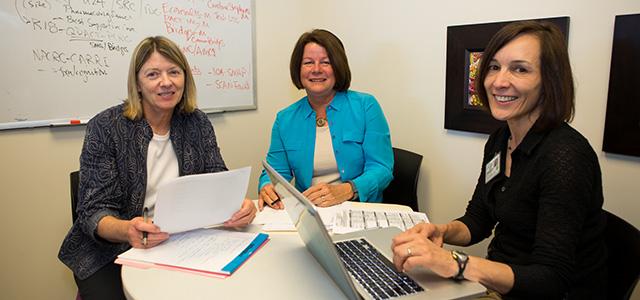
From left: Susan Chapman, Nancy Dudley, Christine Ritchie (photo by Elisabeth Fall)
Can Team-Based Palliative Care Improve Quality of Life for Older Adults?
As a manager for many years in Stanford’s Aging Adult Services program, Nancy Dudley had far too many patients who were at risk of falling through the cracks in a health care system ill prepared to deal with them. Typically, these patients were older adults living with comorbid conditions, including chronic illnesses once considered fatal.
“I’d be called in when they were being readmitted to the emergency room (ER). A lot of them had received specialty care and then lost contact with their primary care physician or even specialty physician [after discharge],” she says. “There were a lot of gaps in coordinating their care.”
A nurse with master’s degrees in nursing administration and gerontology, Dudley knew her patients’ unmet needs went beyond specific diagnoses to what were often stubborn symptoms that drove them to the ER, mental health challenges and “big picture” questions about how they wanted to live and die. She began to believe that the system needed to adapt if it was to help her patients achieve a quality of life that would justify the medical miracles prolonging their lives.
In particular, Dudley wondered if palliative care might have an important role to play for her patients, but also knew that accessing palliative care services outside of the hospital and before end of life can be difficult. Believing that change would likely demand a policy solution, Dudley enrolled in the health policy doctoral program at UC San Francisco School of Nursing; she is now in her third year.
“My particular area of interest is initiation of palliative care upon diagnosis of serious chronic illness: cancer, heart failure, COPD [chronic obstructive pulmonary disease], dementia and end-stage renal disease – people who have five or ten years to live,” she says. “If we could trigger a referral or consult that would provide that extra layer of support for the primary care provider and patient with complex disease, we could prevent so many readmissions.” She is particularly interested in figuring out the role nursing can play to foster improvements in continuity of care.
Dudley’s passion seems well suited to this moment in health care. In April, the National Hartford Centers of Gerontological Nursing Excellence selected Dudley as one of six 2014-2016 Patricia G. Archbold Scholars, an award that carries with it $50,000 per year over the next two years. Dudley says her co-mentor Margaret Wallhagen – who directs the UCSF/John A. Hartford Center of Gerontological Nursing Excellence – has been a “tremendous support.”
Growing Need, Few Tested Models
Geriatrician and palliative care physician Christine Ritchie of UCSF, who is working with Dudley on her doctoral research, says that the health care community is beginning to understand the value palliative care can provide for patients who are not necessarily at the end of their life.
“But we only have about one trained palliative care provider for every 30,000 people who need it,” says Ritchie. “If we don’t have enough individuals with specialty training, then we need to get a strategy in place for delivering the extra layer of support that individuals who have high illness burden deserve.” She adds that the need goes beyond primary care to nursing homes and assisted care facilities, where access to palliative care services is virtually nonexistent.
“From a policy perspective, we need to figure out what [this type of] palliative care looks like,” says Dudley’s doctoral adviser, Susan Chapman of the School of Nursing, who believes Dudley’s work can make an important contribution to a national framework for palliative care. “Which clinical and nonclinical providers are involved? What services are offered? How do we pay for it? What do patients and families need to know to access palliative care?”
A 2013 article in The New England Journal of Medicine provided a beginning outline. It suggests that all providers should be able to practice what might be called first-level palliative care (basic management of pain, symptoms, depression and anxiety, as well as basic discussion about goals of care). Yet it also asserts that primary care providers need clear criteria for referrals to palliative care specialists, who have extensive training working with patients who exhibit refractory symptoms, whose mental health symptoms or existential crises have become more severe and/or whose discussions about goals of care have become more difficult, perhaps involving a need for conflict resolution.
Various prominent institutions around the country are testing ways to flesh out this concept, often with guidance from the Center to Advance Palliative Care and the National Institute of Nursing Research, which has made palliative care one of its priorities.
The Real World as a Leaping-Off Point
Dudley’s work in Stanford’s Aging Adult Services program gave her some important insights into how community-based palliative care might work. The Stanford program brings together a host of services that support Medicare-eligible adults inside and outside of hospital settings and is aimed at enhancing transitions from the hospital, wellness and quality of life.
“I’m a systems person; I like everything coordinated,” says Dudley. “So for me, supporting these people affected by chronic disease means creating better systems.”
 Steve Pantilat, Margaret Wallhagen Working with Ritchie, Chapman, Wallhagen and hospitalist and palliative care expert Steve Pantilat, Dudley has taken a systems approach to her doctoral work. She is examining national survey data on ambulatory care to uncover patterns that include how often patients with complex illness have flare-ups that generate referrals to emergency rooms. She is combining these data with a qualitative study of primary care practitioners that examines their perceptions about the facilitators and barriers for integrating palliative care in the primary care setting.
Steve Pantilat, Margaret Wallhagen Working with Ritchie, Chapman, Wallhagen and hospitalist and palliative care expert Steve Pantilat, Dudley has taken a systems approach to her doctoral work. She is examining national survey data on ambulatory care to uncover patterns that include how often patients with complex illness have flare-ups that generate referrals to emergency rooms. She is combining these data with a qualitative study of primary care practitioners that examines their perceptions about the facilitators and barriers for integrating palliative care in the primary care setting.
One thing her work confirms is the need to educate all primary care practitioners (PCPs) about the meaning of palliative care, especially to distinguish the broader concept of palliation from end-of-life care, which is only one type of palliative care service. “When primary care providers understand the distinction, it facilitates the use of palliative care services,” says Dudley. “When they think about it as only hospice, that’s a barrier because they think [integrating palliative care] means they’re giving up on their patients.”
Another barrier, she says, is the time-limited nature of primary care appointments. PCPs worry that they don’t have the time to offer palliative care; nor do they believe they have the capacity to easily bring in an outside expert for help.
Dudley has begun to believe that one option is having a palliative care expert embedded on-site in some primary care practices. In many situations, she says, this might be a role for an advanced practice nurse trained in palliative care because so many of the related skills – tracking, calling, monitoring, care coordination – are already part of the nurse’s skill set.
Ritchie says that’s a good possibility but notes: “We don’t have one good model yet. In some cases, it might be a nurse practitioner who has additional skills in communication and advanced care planning and symptom support. Or maybe it’s a case manager who identifies patients in need and does basic things and refers to a higher-level care. Maybe a person is embedded in specialty practices as well, such as those for cancer, neurology and vascular assist devices. Maybe for those too sick to come to clinic – but not yet ready for hospice – it’s home-based palliative and primary care.”
Exploring Workable Solutions
Dudley, Ritchie and Chapman recognize that part of Dudley’s exploration must be to examine the cost-effectiveness of any potential model.
“With a traditional fee-for-service model, there are time-related disincentives for these services to be provided,” says Ritchie. “But with the growth of integrated care across the continuum by health care systems, some studies [of the initial experiments with accountable care organizations, or ACOs] have shown these services can lead to better value, higher quality and lower costs.”
One hope, says Dudley, is that the episode-based payments – which can be part of the ACO model, where the “episodes of care” extend over a period of time and multiple visits and services – might create a viable economic model.
She says, “I’m looking at the whole trajectory of illness, which means figuring out the time spent on care coordination, which is not billable today with Medicare. If we can maximize quality of life and show the economic model works because the cost of one emergency readmission outweighs the cost of the additional services, then we can see some change.”
“Right now there is not even a billing code for these services, and we have to find a way of capturing the workflow so we can appropriately understand the cost,” says Ritchie. “A number of us doing work in the field are also developing appropriate measures for quality of care that move away from disease-specific measures, since those don’t really apply for this population; the challenge is measuring the value of interprofessional care, where different disciplines are adding different pieces.”
Chapman believes that is one of the advantages Dudley has as she tries to find the best way to integrate palliative care into primary care. “She already has an interdisciplinary team mentoring her with Christine and Steve.”
“Community-based palliative care is the new frontier for older adults,” says Dudley. “And it’s the different perspectives from the different professions that we’re going to need to tackle the needs of an aging population.”



